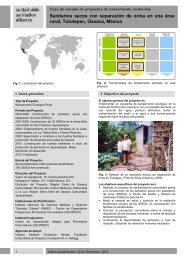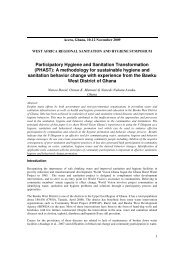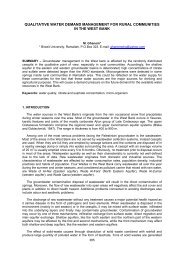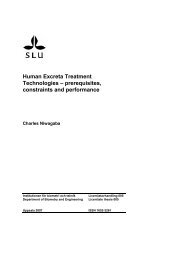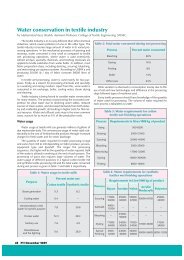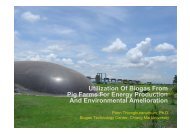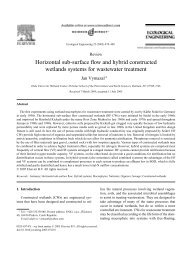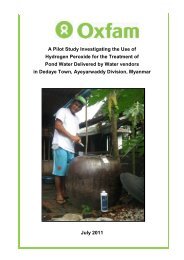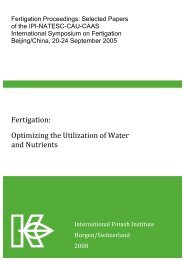Compilation of 13 factsheets on key sustainable sanitation ... - SSWM
Compilation of 13 factsheets on key sustainable sanitation ... - SSWM
Compilation of 13 factsheets on key sustainable sanitation ... - SSWM
Create successful ePaper yourself
Turn your PDF publications into a flip-book with our unique Google optimized e-Paper software.
should not be used as disposal sites for mixed wastewater<br />
systems.<br />
Figure 3: Vertical flow c<strong>on</strong>structed wetland in the “Olympic forest<br />
park” located north <str<strong>on</strong>g>of</str<strong>on</strong>g> the city centre <str<strong>on</strong>g>of</str<strong>on</strong>g> Beijing, Peoples Republic<br />
<str<strong>on</strong>g>of</str<strong>on</strong>g> China, 2008 (source: J. Germer, 2008) 4<br />
.<br />
c) Wet blackwater system<br />
In this system, urine, faeces and flushing water (together<br />
called blackwater) are collected, transported and treated<br />
together. However, greywater is kept separate. Since<br />
greywater accounts for approximately 60% <str<strong>on</strong>g>of</str<strong>on</strong>g> the<br />
wastewater produced in homes owning flush toilets, this<br />
separati<strong>on</strong> simplifies blackwater management. A comm<strong>on</strong><br />
example <str<strong>on</strong>g>of</str<strong>on</strong>g> this system is the double-pit pour flush toilet;<br />
this technology allows users to have the comfort <str<strong>on</strong>g>of</str<strong>on</strong>g> a pourflush<br />
toilet and water seal. Another technology opti<strong>on</strong> is<br />
anaerobic treatment for blackwater with biogas producti<strong>on</strong>.<br />
In this system, a separate process for greywater<br />
management must be implemented. Since separated<br />
greywater c<strong>on</strong>tains few pathogens, and usually low<br />
c<strong>on</strong>centrati<strong>on</strong>s <str<strong>on</strong>g>of</str<strong>on</strong>g> nitrogen and phosphorus, it does not<br />
require the same level <str<strong>on</strong>g>of</str<strong>on</strong>g> treatment as blackwater or mixed<br />
wastewater. Greywater can be treated with soil filters and<br />
recycled for irrigati<strong>on</strong>, toilet flushing, cleaning around the<br />
house etc.<br />
d) Wet urine diversi<strong>on</strong> system<br />
In this system, faeces, flushing water and greywater are<br />
collected, transported and treated together but urine is<br />
kept separate. The diversi<strong>on</strong> <str<strong>on</strong>g>of</str<strong>on</strong>g> urine from the other<br />
flowstreams requires a specific user interface, known as a<br />
urine diversi<strong>on</strong> toilet. Urine can be either collected with or<br />
without flushing water (see v<strong>on</strong> Muench and Winker, 2011,<br />
for a detailed descripti<strong>on</strong> <str<strong>on</strong>g>of</str<strong>on</strong>g> this c<strong>on</strong>cept).<br />
The objective <str<strong>on</strong>g>of</str<strong>on</strong>g> the urine separati<strong>on</strong> is to keep the urine<br />
free <str<strong>on</strong>g>of</str<strong>on</strong>g> pathogens and to ultimately facilitate its reuse in<br />
agriculture. In wet urine diverting systems, the faeces are<br />
flushed with water to an <str<strong>on</strong>g>of</str<strong>on</strong>g>f-site treatment facility.<br />
4 See SuSanA case study for details: www.susana.org/langen/case-studies?view=ccbktypeitem&type=2&id=36<br />
Sometimes the urine is mixed with a small amount <str<strong>on</strong>g>of</str<strong>on</strong>g> flushing<br />
water. Due to the novelty <str<strong>on</strong>g>of</str<strong>on</strong>g> the user interface and the<br />
complicated infrastructure required for this type <str<strong>on</strong>g>of</str<strong>on</strong>g> system, it<br />
is not widely used yet and exists <strong>on</strong>ly in some dem<strong>on</strong>strati<strong>on</strong><br />
projects 5<br />
.<br />
e) Dry excreta and greywater separate system<br />
Here excreta, a mix <str<strong>on</strong>g>of</str<strong>on</strong>g> urine and faeces, are discharged at<br />
the user interface without using any flushing water.<br />
Greywater is collected separately. C<strong>on</strong>sequently, although<br />
the mixture <str<strong>on</strong>g>of</str<strong>on</strong>g> urine and faeces is wet, the system is referred<br />
to as “dry” because there is no flushing water. Depending <strong>on</strong><br />
the cultural habits, anal cleansing water may or may not be<br />
included although odour and flies are minimised if the mixture<br />
is kept as dry as possible. This is particularly true for the<br />
simple composting toilets (such as Arborloo, Fossa alterna)<br />
that can become smelly if too much water is added.<br />
Generally, the system is characterised by “drop and store”<br />
latrines that are emptied or aband<strong>on</strong>ed when full. The<br />
separate greywater should be treated close to where it is<br />
generated (<strong>on</strong>-site-treatment). The faecal sludge may be<br />
further treated <str<strong>on</strong>g>of</str<strong>on</strong>g>f-site. Generally, <str<strong>on</strong>g>of</str<strong>on</strong>g>f-site treatment <str<strong>on</strong>g>of</str<strong>on</strong>g> faecal<br />
sludge for pathogen removal is difficult to organise properly<br />
and unfortunately <str<strong>on</strong>g>of</str<strong>on</strong>g>ten neglected. Households who do not<br />
have sufficient space to move their latrine over a new pit<br />
<strong>on</strong>ce it is full will <str<strong>on</strong>g>of</str<strong>on</strong>g>ten revert to emptying the pits by hand and<br />
burying the sludge in shallow pits nearby. It is possible to<br />
either reuse the recovered resources (greywater or treated<br />
faecal sludge) or to dispose <str<strong>on</strong>g>of</str<strong>on</strong>g> them when interest in reuse is<br />
lacking.<br />
Figure 4: Faecal sludge being discharged from trucks into treatment<br />
beds in Cot<strong>on</strong>ou, Benin (source: S. Blume, 2010).<br />
5 See SuSanA case studies with urine diversi<strong>on</strong> flush toilets in Linz<br />
(Austria) www.susana.org/lang-en/case-studies?view=ccbktype<br />
item&type=2&id=66 and in Eschborn (Germany) - www.susana.<br />
org/lang-en/case-studies?view=ccbktypeitem&type =2&id=63<br />
Sanitati<strong>on</strong> systems, technology opti<strong>on</strong>s, hygiene and health: Working Group 4 - page 4



